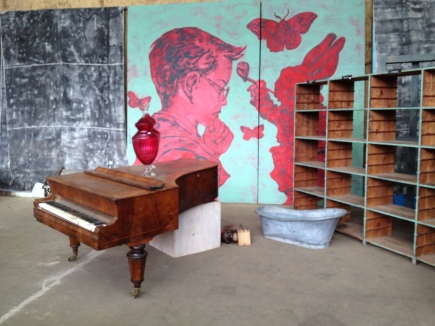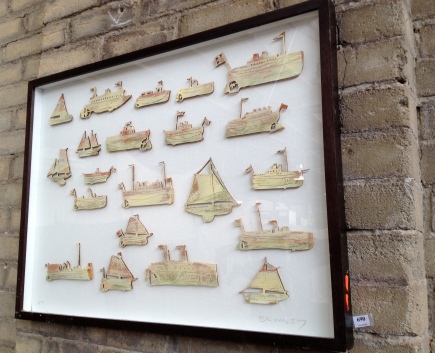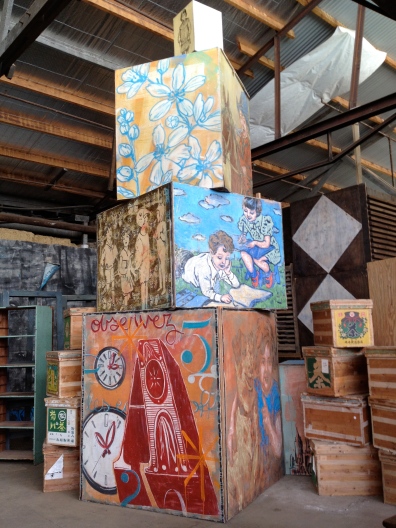Tuesday, 6 December 2011:
It’s the second last day of Unsensored11, and I’m taking the opportunity to hang out at the gallery before the images start coming down tomorrow. Somehow the day that I spent gallery sitting last week flew by and I still want more time to look, and to contemplate the images on display.
There are the four portraits of young women who are part of the punk scene, by Liam White in collaboration with Ada Conroy. The portraits are striking for the fact that they give us nothing of the faces or expressions of the women, but instead give each of them a voice. The voice is captured in the chunk of typewritten text beneath the portraits and inside the frames. There are mistakes in the text in places, thanks to the fallibility of human fingers on typewriter keys. It is appropriate, for surely in telling their story, no-one says it perfectly the first time round. There are always corrections, revisions, maybe some backpedalling.
In using typewritten text, the set of portraits also harks back to the pre-digital past. The whole exhibition does this simply because every image here is captured using film, but no exhibit does this more so than Liam’s. The portraits are analogue-shot, darkroom-printed, typewriter-explained.
There are other images in the exhibition that hark back to the past in different ways. Andrew Cosgriff exhibited “grime”, a black and white photo of Ballarat Railway station. It is an image that could almost have been taken a hundred years ago. A soot-blackened worker leands against the rail, beyond which there is a steam train. There are old-fashioned signals overhead and a thick dark plume of steam clouds the sky. It is only the modern signage – a “Ballarat” sign and another that is a line through a walking stick figure – that really gives the game away. It is, in the end, a photo from the very recent past, harking back to something older.
“At the end of the day” by Timothy D. Johnson also has the past present, subtly. The photograph is of the sun going down into the ocean, but it is shot through the rigging of a tall ship, Leeuwin II. The ship’s capping rail is in focus in the foreground, gleaming a little in the evening light. I’m proud of this one, for it is a ship that I know well and who I have sailed on for years. She is not that old, having been launched 25 years ago, but she is a traditionally-rigged tall ship and so, if you are open to it, she cannot help but make you dream of the past.
The movement in this image can only be remembered or imagined: the invisible wind that must have been blowing that evening. In “grime”, movement is present only in the steam; otherwise, it is an image of calm. The railway worker is just watching, resting or waiting, perhaps.
There are however two shots in the exhibition that are full of movement. They rely on this movement, caught and suspended clearly on film.
I am thinking of “Schooling Jackfish”, shot by Marcus Visic – an image of sleek bodies, bubbles of air, and blue – so much blue. The story behind this shot is quite remarkable, and testament to the resilience of film and the challenges that it can pose for those who remain committed to it.
The other that strikes me for its movement is “The Great Escape”, by Dave Carswell. Click through and you will see why – it is a beautifully composed image, the curving arcs of the boys as they backflip balanced by those who watch them, standing casually on the other edge of the pier.
There are several images of the sea or the coast in this year’s exhibition, unlike last year. Perhaps it is something about the warmer weather, about it being springtime when images are chosen, instead of the depths of winter. One of my favourite sets is “Point Lonsdale Pier”, exhibited by Lea Williams, three polaroids that are blue in theme and that focus on the edges of the land: the point where humans make their contact with the sea. This edge or border between land and sea is the site of my own image in the exhibition, too.
There are many more images in the gallery that draw me to them, that make me think of other things, sometimes clearly related and sometimes not. Consistently for me, though, I am drawn to the images of the ocean. Some of the portraits are engrossing, and images of Melbourne are often striking with their angles and light, but for me, the ocean has a pull that is hard to match.
Unsensored11 closes tonight (7 December). The exhibition is held yearly by the Melbourne Silver Mine, a group that is wholly dedicated to analogue photography and film techniques. This is my second year taking part in the exhibition, and I hope to be back next year!






















